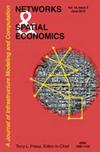俄罗斯对数字技能的需求:地区差异
IF 1.5
3区 工程技术
Q3 OPERATIONS RESEARCH & MANAGEMENT SCIENCE
引用次数: 2
摘要
本文基于对2018-2022年统一数字平台“俄罗斯工作”上发布的900万个职位空缺的分析,研究了数字技能需求的地区差异。我们研究了文献中使用的方法来对数字技能进行分类,并利用它来发展我们自己的分类。本文研究了各种数字技能需求指标的优势和局限性。我们建议以该地区某一群体需要数字技能的职位空缺份额与劳动力人口的比例为最合适的比例。研究结果表明,在俄罗斯,雇主对所有选定群体的需求仍然存在显著的地区差异。随着Covid-19大流行的开始,分化有所增加,并在2021-2022年略有下降。我们发现,经济发展水平越高的地区对数字技能的要求越高。专门从事初级生产的地区往往更需要数字技能,而农业地区则不太需要。在联邦区中,乌拉尔和远东联邦区对数字技能的需求水平略高,而北高加索联邦区对数字技能的需求水平明显较低本文章由计算机程序翻译,如有差异,请以英文原文为准。
Demand on Digital Skills in Russia: Regional Differences
This paper examines regional differences in the demand for digital skills based on an analysis of 9 million vacancies posted on the Unified Digital Platform ‘Work in Russia’ in 2018–2022. We examine approaches used in the literature to classify digital skills and using it develop our own classification. The paper studies the advantages and limitations of various indicators of the demand for digital skills. We suggest that the ratio between the share of vacancies requiring digital skills of a certain group in the region and the labor force population should be used as the most appropriate one. The results of the study show that in Russia there is still a significant regional differentiation in the employer’s demand for all selected groups. Differentiation increased with the beginning of the Covid-19 pandemic, and decreased slightly in 2021–2022. We reveal that regions with a higher level of economic development have higher requirements for digital skills. Digital skills are more often required in regions specialized on primary production and less often in agricultural regions. Of the federal districts, a slightly higher level of demand for digital skills is observed in the Ural and Far Eastern federal districts, while a significantly lower level is observed in the North Caucasus federal district
求助全文
通过发布文献求助,成功后即可免费获取论文全文。
去求助
来源期刊

Networks & Spatial Economics
社会科学-运筹学与管理科学
CiteScore
4.00
自引率
4.20%
发文量
26
审稿时长
>12 weeks
期刊介绍:
Networks and Spatial Economics (NETS) is devoted to the mathematical and numerical study of economic activities facilitated by human infrastructure, broadly defined to include technologies pertinent to information, telecommunications, the Internet, transportation, energy storage and transmission, and water resources. Because the spatial organization of infrastructure most generally takes the form of networks, the journal encourages submissions that employ a network perspective. However, non-network continuum models are also recognized as an important tradition that has provided great insight into spatial economic phenomena; consequently, the journal welcomes with equal enthusiasm submissions based on continuum models.
The journal welcomes the full spectrum of high quality work in networks and spatial economics including theoretical studies, case studies and algorithmic investigations, as well as manuscripts that combine these aspects. Although not devoted exclusively to theoretical studies, the journal is "theory-friendly". That is, well thought out theoretical analyses of important network and spatial economic problems will be considered without bias even if they do not include case studies or numerical examples.
 求助内容:
求助内容: 应助结果提醒方式:
应助结果提醒方式:


